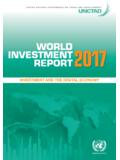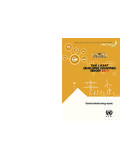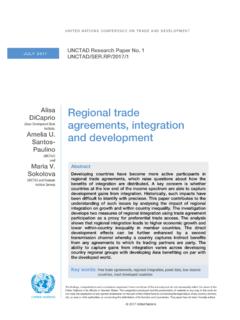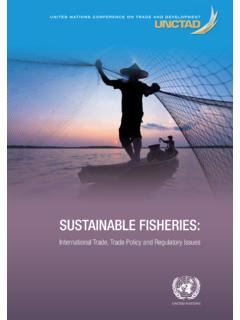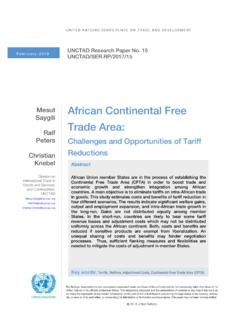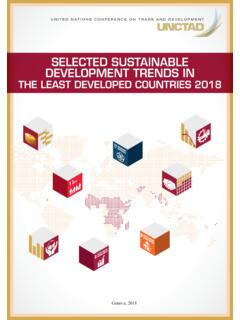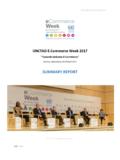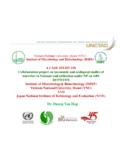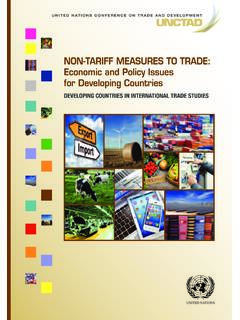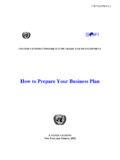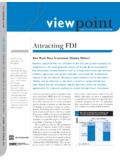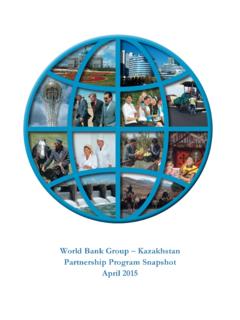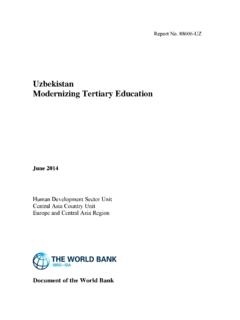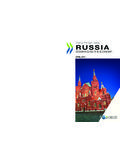Transcription of UNITED NATIONS CONFERENCE ON TRADE AND …
1 U N I T E D N AT I O N S C O N F E R E N C E O N T R A D E A N D D E V E L O P M E N T. world . investment . report 2015 . REFORMING INTERNATIONAL investment GOVERNANCE. New York and Geneva, 2015 . ii world investment report 2015 : Reforming International investment Governance NOTE. The Division on investment and Enterprise of UNCTAD is a global centre of excellence, dealing with issues related to investment and enterprise development in the UNITED NATIONS System. It builds on four decades of experience and international expertise in research and policy analysis, fosters intergovernmental consensus-building, and provides technical assistance to over 150 countries. The terms country/economy as used in this report also refer, as appropriate, to territories or areas; the designations employed and the presentation of the material do not imply the expression of any opinion whatsoever on the part of the Secretariat of the UNITED NATIONS concerning the legal status of any country, territory, city or area or of its authorities, or concerning the delimitation of its frontiers or boundaries.
2 In addition, the designations of country groups are intended solely for statistical or analytical convenience and do not necessarily express a judgment about the stage of development reached by a particular country or area in the development process. The major country groupings used in this report follow the classification of the UNITED NATIONS Statistical Office: Developed countries: the member countries of the OECD (other than Chile, Mexico, the Republic of Korea and Turkey), plus the new European Union member countries which are not OECD. members (Bulgaria, Croatia, Cyprus, Latvia, Lithuania, Malta and Romania), plus Andorra, Bermuda, Liechtenstein, Monaco and San Marino. Transition economies: South-East Europe, the Commonwealth of Independent States and Georgia. Developing economies: in general, all economies not specified above. For statistical purposes, the data for China do not include those for Hong Kong Special Administrative Region (Hong Kong SAR), Macao Special Administrative Region (Macao SAR) and Taiwan Province of China.
3 Reference to companies and their activities should not be construed as an endorsement by UNCTAD of those companies or their activities. The boundaries and names shown and designations used on the maps presented in this publication do not imply official endorsement or acceptance by the UNITED NATIONS . The following symbols have been used in the tables: Two dots (..) indicate that data are not available or are not separately reported. Rows in tables have been omitted in those cases where no data are available for any of the elements in the row. A dash ( ) indicates that the item is equal to zero or its value is negligible. A blank in a table indicates that the item is not applicable, unless otherwise indicated. A slash (/) between dates representing years, , 2010/11, indicates a financial year. Use of a dash ( ) between dates representing years, , 2010 2011, signifies the full period involved, including the beginning and end years.
4 Reference to dollars ($) means UNITED States dollars, unless otherwise indicated. Annual rates of growth or change, unless otherwise stated, refer to annual compound rates. Details and percentages in tables do not necessarily add to totals because of rounding. The material contained in this study may be freely quoted with appropriate acknowledgement. UNITED NATIONS PUBLICATION. Sales No. ISBN 978-92-1-112891-8. eISBN 978-92-1-057403-7. Copyright UNITED NATIONS , 2015 . All rights reserved Printed at UNITED NATIONS , Geneva iii PREFACE. This year's world investment report , the 25th in the series, aims to inform global debates on the future of the international policy environment for cross-border investment . Following recent lackluster growth in the global economy, this year's report shows that Foreign Direct investment (FDI) inflows in 2014 declined 16 per cent to $ trillion.
5 However, recovery is in sight in 2015 and beyond. FDI. flows today account for more than 40 per cent of external development finance to developing and transition economies. This report is particularly timely in light of the Third International CONFERENCE on Financing for Development in Addis Ababa and the many vital discussions underscoring the importance of FDI, international investment policy making and fiscal regimes to the implementation of the new development agenda and progress towards the future sustainable development goals. The world investment report tackles the key challenges in international investment protection and promotion, including the right to regulate, investor-state dispute settlement, and investor responsibility. Furthermore, it examines the fiscal treatment of international investment , including contributions of multinational corporations in developing countries, fiscal leakage through tax avoidance, and the role of offshore investment links.
6 The report offers a menu of options for the reform of the international investment treaties regime, together with a roadmap to guide policymakers at the national, bilateral, regional and multilateral levels. It also proposes a set of principles and guidelines to ensure coherence between international tax and investment policies. I commend this publication as an important tool for the international investment community in this crucial year for sustainable development. BAN Ki-moon Secretary-General of the UNITED NATIONS . iv world investment report 2015 : Reforming International investment Governance ACKNOWLEDGEMENTS. The world investment report 2015 (WIR15) was prepared by a team led by James X. Zhan. The team members included Richard Bolwijn, Kwangouck Byun, Bruno Casella, Joseph Clements, Hamed El Kady, Kumi Endo, Masataka Fujita, Noelia Garcia Nebra, Ax le Giroud, Joachim Karl, Ventzislav Kotetzov, Guoyong Liang, Hafiz Mirza, Shin Ohinata, Sergey Ripinsky, Diana Rosert, William Speller, Astrit Sulstarova, Claudia Trentini, Elisabeth Tuerk, Joerg Weber and Kee Hwee Wee.
7 WIR15 benefited from the advice of Jeffrey Owens, Senior Tax Advisor. Research and statistical assistance was provided by Bradley Boicourt, Mohamed Chiraz Baly and Lizanne Martinez. Contributions were also made by Bekele Amare, Ana Conover Blancas, Hasinah Essop, Charalampos Giannakopoulos, Thomas van Giffen, Natalia Guerra, Rhea Hoffmann, Mathabo Le Roux, Kendra Magraw, Abraham Negash, Chloe Reis, Davide Rigo, Julia Salasky, John Sasuya, Carmen Saugar Koster, Catharine Titi, as well as interns Anna Mouw and Elizabeth Zorrilla. The manuscript was copy-edited with the assistance of Lise Lingo, and typeset by Laurence Duchemin and Teresita Ventura. Sophie Combette and Nadege Hadjemian designed the cover, and Pablo Cortizo designed the figures and maps. Production and dissemination of WIR15 was supported by Elisabeth Anodeau-Mareschal, Anne Bouchet, Nathalie Eulaerts, Rosalina Goyena, Tadelle Taye and Katia Vieu.
8 At various stages of preparation, in particular during the experts meetings organized to discuss drafts of WIR15, the team benefited from comments and inputs received from external experts: Wolfgang Alschner, Carlo Altomonte, Douglas van den Berghe, Nathalie Bernasconi, Yvonne Bol, David Bradbury, Irene Burgers, Jansen Calamita, Krit Carlier, Manjiao Chi, Steve Clark, Alex Cobham, Aaron Cosbey, Lorrain Eden, Maikel Evers, Uche Ewelukwa, Michael Ewing-Chow, Alessio Farcomeni, Michael Hanni, Martin Hearson, Steffen Hindelang, Lise Johnson, Michael Keen, Eric Kemmeren, Jan Kleinheisterkamp, Victor van Kommer, Markus Krajewski, Federico Lavopa, Michael Lennard, Jan Loeprick, Ricardo Martner, Makane Mbengue, Nara Monkam, Hans Mooij, Ruud de Mooij, Peter Muchlinski, Alexandre Munoz, Thomas Neubig, Andrew Packman, Joost Pauwelyn, Facundo Perez Aznar, Raffaella Piccarreta, Andrea Saldarriaga, Mavluda Sattorova, Ilan Strauss, Lauge Skovgaard Poulsen, Christian Tietje, Jan van den Tooren, Gerben Weistra and Paul Wessendorp.
9 MEED provided assistance in obtaining data for the West Asia region. Also acknowledged are comments received from other UNCTAD divisions, including from the Division for Africa, Least Developed Countries and Special Programmes, the Division on Globalization and Development Strategies, and the Division on Technology and Logistics, as part of the internal peer review process, as well as comments from the Office of the Secretary-General as part of the review and clearance process. The UNITED NATIONS Cartographic Section provided advice for the regional maps. Numerous officials of central banks, government agencies, international organizations and non-governmental organizations also contributed to WIR15. The financial support of the Governments of Finland, Norway, Sweden and Switzerland is gratefully acknowledged. v TABLE OF CONTENTS. PREFACE .. iii ACKNOWLEDGEMENTS.. iv ABBREVIATIONS.
10 Viii KEY MESSAGES.. ix CHAPTER I. GLOBAL investment TRENDS .. 1. A. CURRENT TRENDS.. 2. 1. FDI by geography .. 2. 2. FDI by mode of entry .. 8. 3. FDI by sector and industry .. 12. 4. FDI by selected types of investors .. 14. B. INTERNATIONAL PRODUCTION .. 18. C. PROSPECTS .. 21. 1. UNCTAD's econometric forecasting model .. 21. 2. UNCTAD business survey .. 22. CHAPTER II. REGIONAL investment TRENDS .. 29. INTRODUCTION .. 30. A. REGIONAL TRENDS .. 32. 1. Africa .. 32. 2. East and South-East Asia .. 39. 3. South Asia .. 46. 4. West Asia .. 52. 5. Latin America and the Caribbean .. 58. 6. Transition economies .. 65. 7. Developed countries .. 71. B. TRENDS IN STRUCTURALLY WEAK, VULNERABLE AND SMALL ECONOMIES.. 78. 1. Least developed countries .. 78. 2. Landlocked developing countries .. 85. 3. Small island developing States .. 91. vi world investment report 2015 : Reforming International investment Governance CHAPTER III.
